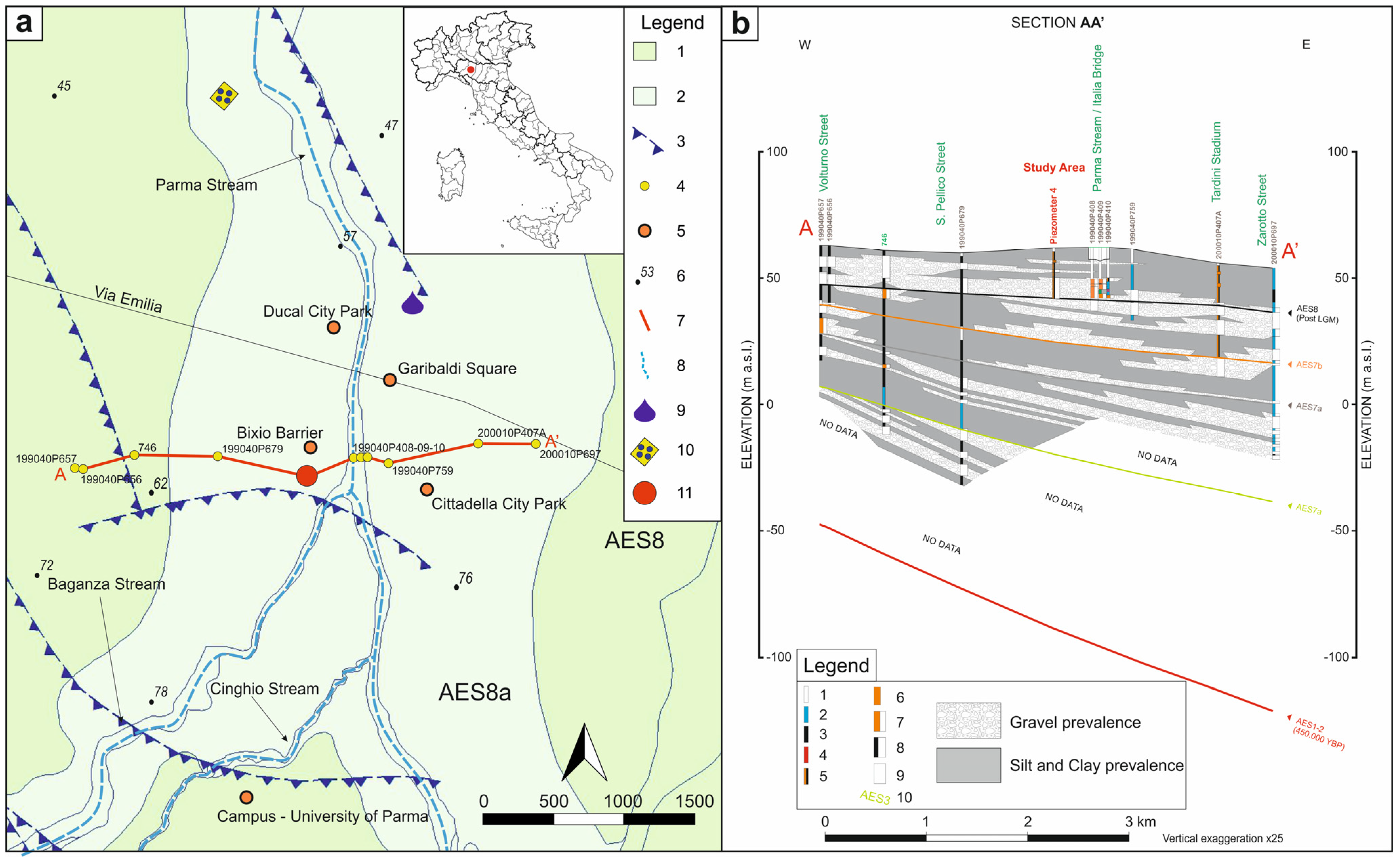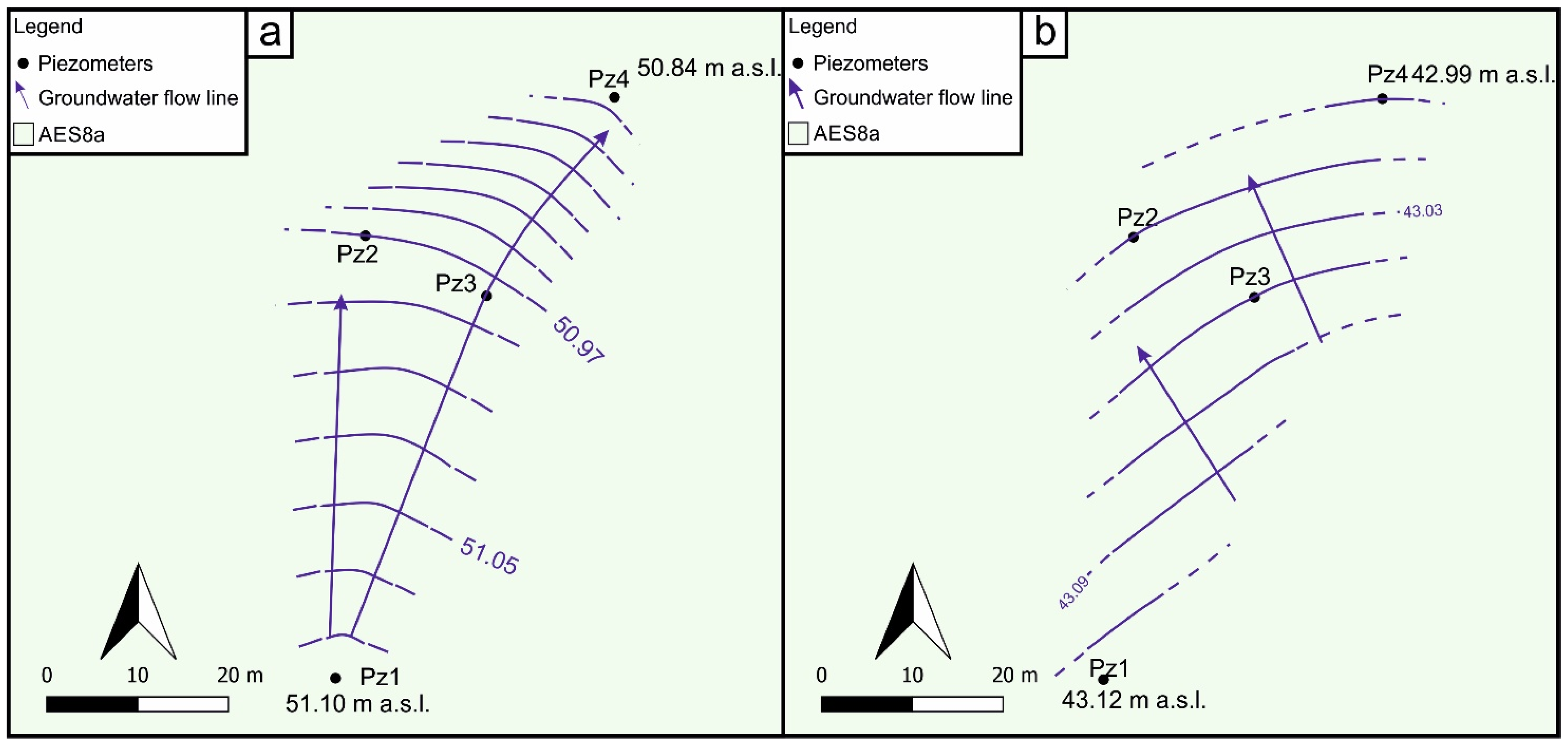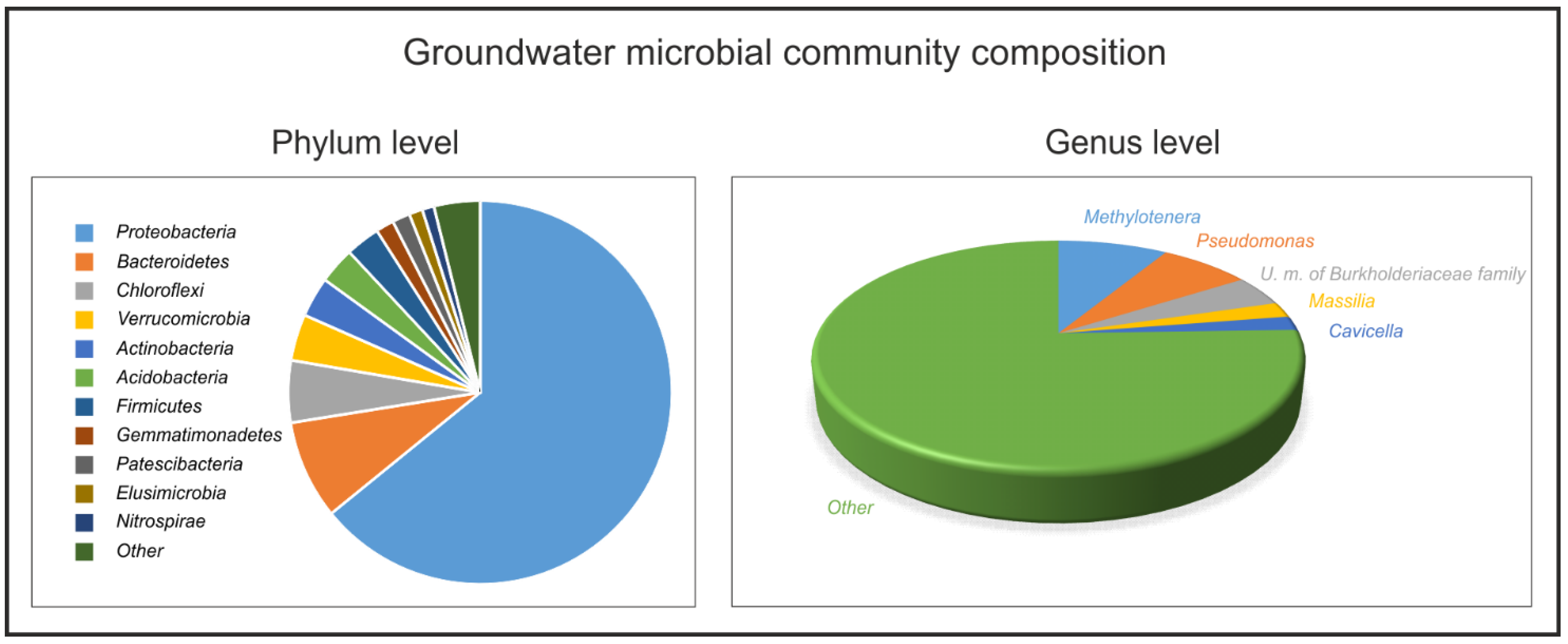The Challenge Posed by Emerging Environmental Contaminants: An Assessment of the Effectiveness of Phenoxyethanol Biological Removal from Groundwater through Mesocosm Experiments
Abstract
1. Introduction
2. Materials and Methods
2.1. Study Area
2.2. Groundwater Sampling and Mesocosm Setup
2.3. Temperature Monitoring and Chemical Analyses for Phy-Et Detection
2.4. Next-Generation Sequencing (NGS) for Bacterial Community Analyses
3. Results
3.1. Microbiological and Physico-Chemical Characterization of Groundwater
3.2. Results of Physico-Chemical and Microbiological Analyses for the Mesocosm Experiments
4. Discussion
5. Conclusions
Supplementary Materials
Author Contributions
Funding
Institutional Review Board Statement
Informed Consent Statement
Data Availability Statement
Acknowledgments
Conflicts of Interest
References
- Fuller, R.; Landrigan, P.J.; Balakrishnan, K.; Bathan, G.; Bose-O’Reilly, S.; Brauer, M.; Caravanos, J.; Chiles, T.; Cohen, A.; Corra, L.; et al. Pollution and health: A progress update. Lancet Planet. Health 2022, 6, e535–e547. [Google Scholar] [CrossRef] [PubMed]
- Landrigan, P.J.; Fuller, R.; Acosta, N.J.; Adeyi, O.; Arnold, R.; Basu, N.; Baldé, A.B.; Bertollini, R.; Bose-O’Reilly, S.; Boufford, J.I.; et al. The Lancet Commission on pollution and health. Lancet 2018, 391, 462–512. [Google Scholar] [CrossRef] [PubMed]
- Yadav, D.; Rangabhashiyam, S.; Verma, P.; Singh, P.; Devi, P.; Kumar, P.; Hussain, C.M.; Gaurav, G.K.; Kumar, K.S. Environmental and health impacts of contaminants of emerging concerns: Recent treatment challenges and approaches. Chemosphere 2021, 272, 129492. [Google Scholar] [CrossRef]
- Vasilachi, I.C.; Asiminicesei, D.M.; Fertu, D.I.; Gavrilescu, M. Occurrence and fate of emerging pollutants in water environment and options for their removal. Water 2021, 13, 181. [Google Scholar] [CrossRef]
- Geissen, V.; Mol, H.; Klumpp, E.; Umlauf, G.; Nadal, M.; van der Ploeg, M.; van de Zee, S.E.A.T.M.; Ritsema, C.J. Emerging pollutants in the environment: A challenge for water resource management. Int. Soil Water Conserv. Res. 2015, 3, 57–65. [Google Scholar] [CrossRef]
- Snow, D.D.; Cassada, D.A.; Larsen, M.L.; Mware, N.A.; Li, X.; D’Alessio, M.; Zhang, Y.; Sallach, J.B. Detection, occurrence and fate of emerging contaminants in agricultural environments. Water Environ. Res. 2017, 89, 897–920. [Google Scholar] [CrossRef] [PubMed]
- Gomes, A.R.; Justino, C.; Rocha-Santos, T.; Freitas, A.C.; Duarte, A.C.; Pereira, R. Review of the ecotoxicological effects of emerging contaminants to soil biota. J. Environ. Sci. Health Part A 2017, 52, 992–1007. [Google Scholar] [CrossRef]
- Risk Assessment Guidance for Superfund Volume 1. Human Health Evaluation Manual (Part E, Supplemental Guidance for Dermal Risk Assessment), EPA/540/R/99/005 Office of Superfund Remediation and Technology Innovation. U.S. Environmental Protection Agency: Washington, DC, USA. Available online: https://www.epa.gov/sites/production/files/2015-09/documents/part_e_final_revision_10-03-07.pdf (accessed on 12 October 2020).
- United States Environmental Protection Agency (USEPA). Contaminants of Emerging Concern Including Pharmaceuticals and Personal Care Products. Washington, DC, USA. Available online: https://www.epa.gov/wqc/contaminants-emerging-concern-including-Pharmaceuticals-and-personal-care-products (accessed on 12 October 2020).
- Patel, M.; Kumar, R.; Kishor, K.; Mlsna, T.; Pittman, C.U., Jr.; Mohan, D. Pharmaceuticals of emerging concern in aquatic systems: Chemistry, occurrence, effects, and removal methods. Chem. Rev. 2019, 119, 3510–3673. [Google Scholar] [CrossRef]
- Baken, K.A.; Sjerps, R.M.; Schriks, M.; van Wezel, A.P. Toxicological risk assessment and prioritization of drinking water relevant contaminants of emerging concern. Environ. Int. 2018, 118, 293–303. [Google Scholar] [CrossRef]
- Khatib, J.M.; Baydoun, S.; ElKordi, A.A. Water pollution and urbanisation trends in Lebanon: Litani River basin case study. In Urban Pollution: Science and Management; John Wiley & Sons Ltd.: Hoboken, NJ, USA, 2018; pp. 397–415. [Google Scholar] [CrossRef]
- Petrie, B.; Barden, R.; Kasprzyk-Hordern, B. A review on emerging contaminants in wastewaters and the environment: Current knowledge, understudied areas and recommendations for future monitoring. Water Res. 2015, 72, 3–27. [Google Scholar] [CrossRef]
- Park, J.; Yamashita, N.; Park, C.; Shimono, T.; Takeuchi, D.M.; Tanaka, H. Removal characteristics of Pharmaceuticals and Personal Care Products: Comparison between membrane bioreactor and various biological treatment processes. Chemosphere 2017, 179, 347–358. [Google Scholar] [CrossRef]
- Akgündüz, M.Ç.; Çavuşoğlu, K.; Yalçın, E. The potential risk assessment of Phenoxyethanol with a versatile model system. Sci. Rep. 2020, 10, 1209. [Google Scholar] [CrossRef]
- Wang, J.; Liu, Y.; Kam, W.R.; Li, Y.; Sullivan, D.A. Toxicity of the cosmetic preservatives parabens, phenoxyethanol and chlorphenesin on human meibomian gland epithelial cells. Exp. Eye Res. 2020, 196, 108057. [Google Scholar] [CrossRef]
- Panico, A.; Serio, F.; Bagordo, F.; Grassi, T.; Idolo, A.; De Giorgi, M.; Guido, M.; Congedo, M.; De Donno, A. Skin safety and health prevention: An overview of chemicals in cosmetic products. J. Prev. Med. Hyg. 2019, 60, E50. [Google Scholar]
- Gilbert, P.; Beveridge, E.G.; Crone, P.B. The action of Phenoxyethanol upon respiration and dehydrogenase enzyme systems in Escherichia coli. J. Pharm. Pharmacol. Suppl. 1976, 28, 51. [Google Scholar]
- Lowe, I.; Southern, J. The antimicrobial activity of Phenoxyethanol in vaccines. Lett. Appl. Microbiol. 1994, 18, 115–116. [Google Scholar] [CrossRef] [PubMed]
- Dréno, B.; Zuberbier, T.; Gelmetti, C.; Gontijo, G.; Marinovich, M. Safety review of Phenoxyethanol when used as a preservative in cosmetics. J. Eur. Acad. Dermatol. Venereol. 2019, 33, 15–24. [Google Scholar] [CrossRef]
- Ducci, L.; Rizzo, P.; Pinardi, R.; Solfrini, A.; Maggiali, A.; Pizzati, M.; Balsamo, F.; Celico, F. What Is the Impact of Leaky Sewers on Groundwater Contamination in Urban Semi-Confined Aquifers? A Test Study Related to Fecal Matter and Personal Care Products (PCPs). Hydrology 2022, 10, 3. [Google Scholar] [CrossRef]
- Di Dio, G.; Lasagna, S.; Preti, D.; Sagne, M. Carta geologica dei depositi quaternari della provincia di Parma. Il Quat. 1997, 10, 443–450. [Google Scholar]
- Di Dio, G. Applicazione di Concetti e Metodi della Stratigrafia Fisica alla Ricerca di Risorse Idriche nel Sottosuolo della Pianura Emiliano-Romagnola; Serie 3a; Giornale di Geologia: Bologna, Italy, 1998; Volume 60, pp. 35–39. [Google Scholar]
- Regione Emilia-Romagna; ENI-AGIP. Riserve Idriche Sotterranee Della Regione Emilia-Romagna; Cura di, A., Di Dio, G.M., Eds.; Regione Emilia-Romagna, ENI Agip Divisione Esplorazione e Produzione; S.EL.CA: Firenze, Italy, 1998; p. 120. [Google Scholar]
- Pinardi, R.; Feo, A.; Ruffini, A.; Celico, F. Purpose-Designed Hydrogeological Maps for Wide Interconnected Surface–Groundwater Systems: The Test Example of Parma Alluvial Aquifer and Taro River Basin (Northern Italy). Hydrology 2023, 10, 127. [Google Scholar] [CrossRef]
- Zanini, A.; Ghirardi, M.; Emiliani, R. A multidisciplinary approach to evaluate the effectiveness of natural attenuation at a contaminated site. Hydrology 2021, 8, 101. [Google Scholar] [CrossRef]
- Di Dio, G.; Martini, A.; Lasagna, S.; Zanzucchi, G. Illustrative Notes of the Geological Map of Italy at 1:50,000 Scale Sheet 199 Parma Sud. Geological, Seismic, and Soil Service of the Emilia-Romagna Region, APAT-Geological Service of Italy; S.EL.CA: Florence, Italy, 2005. [Google Scholar]
- UNI EN ISO 9001:2015; Quality Management Systems Requirements. International Organization for Standardization: Geneva, Switzerland, 2015.
- UNI EN ISO 13485:2016; Medical Devices—Quality Management Systems—Requirements for Regulatory Purposes. International Organization for Standardization: Geneva, Switzerland, 2016.
- Van Boeckel, T.P.; Gandra, S.; Ashok, A.; Caudron, Q.; Grenfell, B.T.; Levin, S.A.; Laxminarayan, R. Global antibiotic consumption 2000 to 2010: An analysis of national Pharmaceutical sales data. Lancet Infect. Dis. 2014, 14, 742–750. [Google Scholar] [CrossRef]
- Adeleye, A.S.; Xue, J.; Zhao, Y.; Taylor, A.A.; Zenobio, J.E.; Sun, Y.; Han, Z.; Salawu, O.A.; Zhu, Y. Abundance, fate, and effects of Pharmaceuticals and Personal Care Products in aquatic environments. J. Hazard. Mater. 2022, 424, 127284. [Google Scholar] [CrossRef]
- Khan, S.; Naushad, M.; Govarthanan, M.; Iqbal, J.; Alfadul, S.M. Emerging contaminants of high concern for the environment: Current trends and future research. Environ. Res. 2022, 207, 112609. [Google Scholar] [CrossRef]
- Lozano, I.; Pérez-Guzmán, C.J.; Mora, A.; Mahlknecht, J.; Aguilar, C.L.; Cervantes-Avilés, P. Pharmaceuticals and Personal Care Products in water streams: Occurrence, detection, and removal by electrochemical advanced oxidation processes. Sci. Total Environ. 2022, 827, 154348. [Google Scholar] [CrossRef]
- Jarque, S.; Quirós, L.; Grimalt, J.O.; Gallego, E.; Catalan, J.; Lackner, R.; Piña, B. Background fish feminization effects in European remote sites. Sci. Rep. 2015, 5, 11292. [Google Scholar] [CrossRef]
- Kalia, V.C. Pharmaceutical and personal care product contamination: A global scenario. In Pharmaceuticals and Personal Care Products: Waste Management and Treatment Technology; Butterworth-Heinemann: Oxford, UK, 2019; pp. 27–61. [Google Scholar] [CrossRef]
- Zhang, X.; Yan, S.; Chen, J.; Tyagi, R.D.; Li, J. Physical, chemical, and biological impact (hazard) of hospital wastewater on environment: Presence of Pharmaceuticals, pathogens, and antibiotic-resistance genes. In Current Developments in Biotechnology and Bioengineering; Elsevier: Amsterdam, The Netherlands, 2020; pp. 79–102. [Google Scholar] [CrossRef]
- Segadelli, S.; Vescovi, P.; Ogata, K.; Chelli, A.; Zanini, A.; Boschetti, T.; Petrella, E.; Toscani, L.; Gargini, A.; Celico, F. A conceptual hydrogeological model of ophiolitic aquifers (serpentinised peridotite): The test example of Mt. Prinzera (North. Italy). Hydrol. Process. 2017, 31, 1058–1073. [Google Scholar] [CrossRef]
- Allocca, V.; Celico, F.; Petrella, E.; Marzullo, G.; Naclerio, G. The role of land use and environmental factors on microbial pollution of mountainous limestone aquifers. Environ. Geol. 2008, 55, 277–283. [Google Scholar] [CrossRef]
- CIR (Cosmetic Ingredient Review). Final report on the safety assessment of Phenoxyethanol. J. Am. Coll. Toxicol. 1990, 9, 259–278. [Google Scholar] [CrossRef]
- Orsi, W.D.; Smith, J.M.; Liu, S.; Liu, Z.; Sakamoto, C.M.; Wilken, S.; Poirier, C.; Richards, T.A.; Keeling, P.J.; Worden, A.Z.; et al. Diverse, uncultivated bacteria and archaea underlying the cycling of dissolved protein in the ocean. ISME J. 2016, 10, 2158–2173. [Google Scholar] [CrossRef] [PubMed]
- Gorokhova, E.; Motiei, A.; El-Shehawy, R. Understanding biofilm formation in ecotoxicological assays with natural and anthropogenic particulates. Front. Microbiol. 2021, 12, 632947. [Google Scholar] [CrossRef]
- Yilmaz, P.; Yarza, P.; Rapp, J.Z.; Glöckner, F.O. Expanding the world of marine bacterial and archaeal clades. Front. Microbiol. 2016, 6, 1524. [Google Scholar] [CrossRef]
- Caldwell, D.J.; Mastrocco, F.; Margiotta-Casaluci, L.; Brooks, B.W. An integrated approach for prioritizing Pharmaceuticals found in the environment for risk assessment, monitoring and advanced research. Chemosphere 2014, 115, 4–12. [Google Scholar] [CrossRef]
- Fatta-Kassinos, D.; Meric, S.; Nikolaou, A. Pharmaceutical residues in environmental waters and wastewater: Current state of knowledge and future research. Anal. Bioanal. Chem. 2011, 399, 251–275. [Google Scholar] [CrossRef] [PubMed]
- Khetan, S.K.; Collins, T.J. Human Pharmaceuticals in the aquatic environment: A challenge to green chemistry. Chem. Rev. 2007, 107, 2319–2364. [Google Scholar] [CrossRef] [PubMed]
- Tran, N.; Drogui, P.; Brar, S.K. Sonochemical techniques to degrade Pharmaceutical organic pollutants. Environ. Chem. Lett. 2015, 13, 251–268. [Google Scholar] [CrossRef]
- Li, W.C. Occurrence, sources, and fate of Pharmaceuticals in aquatic environment and soil. Environ. Pollut. 2014, 187, 193–201. [Google Scholar] [CrossRef] [PubMed]
- Michael, I.; Rizzo, L.; McArdell, C.S.; Manaia, C.M.; Merlin, C.; Schwartz, T.; Dagot, C.; Fatta-Kassinos, D. Urban wastewater treatment plants as hotspots for the release of antibiotics in the environment: A review. Water Res. 2013, 47, 957–995. [Google Scholar] [CrossRef] [PubMed]
- Sharma, V.K.; Anquandah, G.A.; Nesnas, N. Kinetics of the oxidation of endocrine disruptor nonylphenol by ferrate (VI). Environ. Chem. Lett. 2009, 7, 115–119. [Google Scholar] [CrossRef]
- Taylor, D.; Senac, T. Human Pharmaceutical products in the environment—The “problem” in perspective. Chemosphere 2014, 115, 95–99. [Google Scholar] [CrossRef] [PubMed]
- Anquandah, G.A.; Sharma, V.K.; Panditi, V.R.; Gardinali, P.R.; Kim, H.; Oturan, M.A. Ferrate (VI) oxidation of propranolol: Kinetics and products. Chemosphere 2013, 91, 105–109. [Google Scholar] [CrossRef] [PubMed]
- Kuzmanović, M.; Ginebreda, A.; Petrović, M.; Barceló, D. Risk assessment based prioritization of 200 organic micropollutants in 4 Iberian rivers. Sci. Total Environ. 2015, 503, 289–299. [Google Scholar] [CrossRef] [PubMed]
- Petrović, M.; Škrbić, B.; Živančev, J.; Ferrando-Climent, L.; Barcelo, D. Determination of 81 Pharmaceutical drugs by high performance liquid chromatography coupled to mass spectrometry with hybrid triple quadrupole–linear ion trap in different types of water in Serbia. Sci. Total Environ. 2014, 468, 415–428. [Google Scholar] [CrossRef] [PubMed]
- Qin, Q.; Chen, X.; Zhuang, J. The fate and impact of Pharmaceuticals and Personal Care Products in agricultural soils irrigated with reclaimed water. Crit. Rev. Environ. Sci. Technol. 2015, 45, 1379–1408. [Google Scholar] [CrossRef]
- Sharma, V.K.; Anquandah, G.A.; Yngard, R.A.; Kim, H.; Fekete, J.; Bouzek, K.; Ray, A.K.; Golovko, D. Nonylphenol, octylphenol, and bisphenol-A in the aquatic environment: A review on occurrence, fate, and treatment. J. Environ. Sci. Health Part A 2009, 44, 423–442. [Google Scholar] [CrossRef]
- Sharma, V.K.; Liu, F.; Tolan, S.; Sohn, M.; Kim, H.; Oturan, M.A. Oxidation of β-lactam antibiotics by ferrate (VI). Chem. Eng. J. 2013, 221, 446–451. [Google Scholar] [CrossRef]
- Tölgyesi, Á.; Verebey, Z.; Sharma, V.K.; Kovacsics, L.; Fekete, J. Simultaneous determination of corticosteroids, androgens, and progesterone in river water by liquid chromatography–tandem mass spectrometry. Chemosphere 2010, 78, 972–979. [Google Scholar] [CrossRef]
- Verlicchi, P.; Galletti, A.; Petrovic, M.; Barceló, D. Hospital effluents as a source of emerging pollutants: An overview of micropollutants and sustainable treatment options. J. Hydrol. 2010, 389, 416–428. [Google Scholar] [CrossRef]






| Taxonomy | Pz3 | Line α | Line β |
|---|---|---|---|
| Proteobacteria | 64.14% | 62.92% | 76.36% |
| Bacteroidetes | 8.34% | 12.71% | 7.51% |
| Chloroflexi | 5.23% | 1.27% | 1.02% |
| Verrucomicrobia | 3.91% | 5.68% | 3.03% |
| Actinobacteria | 3.38% | 3.69% | 2.70% |
| Acidobacteria | 3.07% | 5.08% | 2.92% |
| Firmicutes | 2.90% | 0.22% | 0.32% |
| Gemmatimonadetes | 1.53% | 0.65% | 0.23% |
| Patescibacteria | 1.49% | 2.78% | 3.08% |
Disclaimer/Publisher’s Note: The statements, opinions and data contained in all publications are solely those of the individual author(s) and contributor(s) and not of MDPI and/or the editor(s). MDPI and/or the editor(s) disclaim responsibility for any injury to people or property resulting from any ideas, methods, instructions or products referred to in the content. |
© 2024 by the authors. Licensee MDPI, Basel, Switzerland. This article is an open access article distributed under the terms and conditions of the Creative Commons Attribution (CC BY) license (https://creativecommons.org/licenses/by/4.0/).
Share and Cite
Ducci, L.; Rizzo, P.; Bucci, A.; Pinardi, R.; Monaco, P.; Celico, F. The Challenge Posed by Emerging Environmental Contaminants: An Assessment of the Effectiveness of Phenoxyethanol Biological Removal from Groundwater through Mesocosm Experiments. Sustainability 2024, 16, 2183. https://doi.org/10.3390/su16052183
Ducci L, Rizzo P, Bucci A, Pinardi R, Monaco P, Celico F. The Challenge Posed by Emerging Environmental Contaminants: An Assessment of the Effectiveness of Phenoxyethanol Biological Removal from Groundwater through Mesocosm Experiments. Sustainability. 2024; 16(5):2183. https://doi.org/10.3390/su16052183
Chicago/Turabian StyleDucci, Laura, Pietro Rizzo, Antonio Bucci, Riccardo Pinardi, Pamela Monaco, and Fulvio Celico. 2024. "The Challenge Posed by Emerging Environmental Contaminants: An Assessment of the Effectiveness of Phenoxyethanol Biological Removal from Groundwater through Mesocosm Experiments" Sustainability 16, no. 5: 2183. https://doi.org/10.3390/su16052183
APA StyleDucci, L., Rizzo, P., Bucci, A., Pinardi, R., Monaco, P., & Celico, F. (2024). The Challenge Posed by Emerging Environmental Contaminants: An Assessment of the Effectiveness of Phenoxyethanol Biological Removal from Groundwater through Mesocosm Experiments. Sustainability, 16(5), 2183. https://doi.org/10.3390/su16052183












